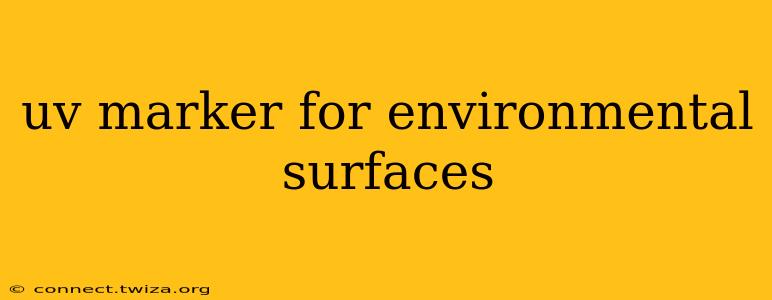Ultraviolet (UV) markers are specialized marking tools that utilize UV-reactive inks invisible under normal lighting conditions but brightly fluorescent under UV light. Their applications are diverse, extending far beyond simple tagging; they're increasingly used in environmental monitoring and analysis. This guide delves into the uses, benefits, and considerations of UV markers for environmental surfaces.
What are UV Markers Used For in Environmental Applications?
UV markers offer a discreet and effective way to mark various environmental surfaces for tracking, monitoring, and analysis. Some common uses include:
- Wildlife Tracking: Researchers can mark animals (non-invasively, using appropriate techniques) to track their movements and behavior without causing distress or altering their natural habits. The markings are only visible during nighttime surveys using UV light.
- Erosion and Sediment Studies: Marking specific points on soil, rocks, or sediment allows researchers to observe erosion patterns and sediment transport over time. The markings provide clear, long-lasting visual indicators even in challenging environments.
- Water Source Identification: Marking water sources or specific points within a water body (e.g., outflow points) can be essential for hydrological studies and pollution tracing.
- Plant Studies: Marking plants for identification and tracking growth patterns can be done discreetly with UV markers, preventing disturbance.
- Forensic Investigations: While not strictly environmental, UV markers can play a role in environmental crime investigations, such as marking evidence related to pollution or illegal dumping.
What are the Benefits of Using UV Markers on Environmental Surfaces?
Several advantages make UV markers ideal for environmental monitoring:
- Non-invasive: The markers are largely invisible to the naked eye, minimizing disturbance to the environment and its inhabitants.
- Long-lasting: UV-reactive inks are designed to withstand weathering and environmental factors, providing reliable tracking data over extended periods.
- Easy Identification: Under UV light, the markings are clearly visible, simplifying data collection and analysis.
- Discreet Tracking: The inconspicuous nature prevents any alteration of natural behaviors in animals or plants being monitored.
- Versatility: UV markers can be applied to various surfaces, including rock, soil, plants (carefully and ethically), and even water (though specific formulations may be required).
What Types of UV Markers are Available?
Several types of UV markers cater to different environmental applications:
- UV Pens: These are the most common type, offering varying ink viscosity for different surface types.
- UV Sprays: Ideal for larger areas, UV sprays offer broader coverage and are suited for marking larger territories or water bodies (with appropriate safety precautions).
- UV Powders: Some specialized applications might use UV-reactive powders, often mixed with other substances for specific marking purposes.
How Durable are UV Markers in Different Environmental Conditions?
The durability of UV markers depends largely on the specific ink formulation and the environmental conditions. Factors affecting longevity include:
- Sunlight Exposure: Prolonged exposure to direct sunlight can fade some UV inks, though many formulations are designed to resist degradation for extended periods.
- Water Exposure: Water resistance varies between different UV inks. Some are designed for underwater use, while others may fade or wash away with prolonged water exposure.
- Temperature Fluctuations: Extreme temperatures can affect the longevity of UV ink.
What Safety Precautions Should Be Taken When Using UV Markers?
Although generally safe, certain safety precautions should be followed:
- Skin and Eye Protection: Always wear appropriate gloves and eye protection when using UV markers, especially sprays, to prevent skin irritation or accidental eye contact.
- Proper Ventilation: Ensure adequate ventilation when using sprays or powders to avoid inhalation of particles.
- Disposal: Dispose of used markers and associated materials according to local regulations to minimize environmental impact.
- Ethical Considerations: When using UV markers for wildlife tracking or other ecological studies, it's crucial to follow ethical guidelines and obtain necessary permits to ensure minimal impact on the environment.
Are there any limitations to using UV markers for environmental monitoring?
- Cost: Specialized UV markers and equipment can be more expensive than traditional markers.
- UV Light Source Requirement: Requires a UV light source for detection, adding to the equipment cost and logistical considerations.
- Potential for Fading: Though designed for durability, fading can occur under prolonged harsh environmental conditions.
- Ethical considerations related to animal tracking: It is crucial to ensure that UV marking does not negatively affect the animals being studied, and to obtain necessary permits.
This comprehensive guide provides a solid foundation for understanding the applications, benefits, and limitations of UV markers in various environmental contexts. Remembering to prioritize safety and ethical considerations will ensure the responsible and effective use of this valuable tool for environmental monitoring and research.
